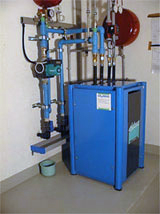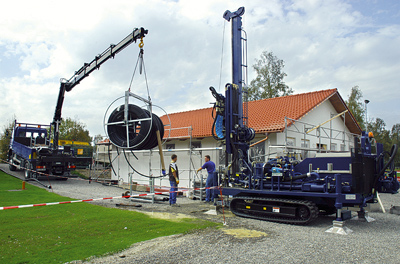- Start / Language
- HHO powered Powerplant
- HHO Systems in Cars
- Geothermal Energy
- Geotherm in Romania
- Partner and Links
- Sponsoring
Terrestrial Heat Probes
Overview
Single terrestrial heat probe plants represent recently the most used type of low-depth Geotherm in Switzerland.
The terrestrial heat probe (THP), an underground heat exchanger
A THP gives the possibility to use terrestrial heat in a depth of 400m already.
Once a drilling took place, the THP forms a closed cycle and forms the heat exchange with the underground.This gives the possibility to use terrestrial heat the ground, which cools down first easily and adjusts themselves after some years to a relatively constant equilibrium.
The heat transfer liquid, consisting of water and antifreeze-liquid, transports the energy, by circulating in the U-tubes.
The length of a THP depends on the soil characteristics as well as on the necessary amount of heat.

Increase of the temperature level of the underground warmth
 For
a new family house the typical depth of a THP is about 120 to 150 m.
For
a new family house the typical depth of a THP is about 120 to 150 m.
The temperature in this depth is constant during the whole yearl and is around 12 to 15° C.
The usability of the energy from the underground is increased by the use of a heat pump (HP), as the temperature level herewith can be raised, so rooms can be heated and additionally the need of warm water can be covered.
This technology is commonly used in central Switzerland and can be used in new built family houses as well as in larger, new or reconditioned buildings.
Heating and cooling
Terrestrial heat probe can also be used for cooling in summertime, if a depth of approximately 200 m is not exceeded. With this possibility of the double-advantage of a combined use of heating in winter and cooling in summer, a building can be optimally air-conditioned as required. In addition to this, the additional and not used energy, which results during the cooling of the buildings in summer, is stored into the ground.
A permanent and profitable investment
Heating systems with terrestrial heat probes are very profitable, both from the technical and economic view.
The grant procedure is regulated Das Bewilligungsverfahren ist kantonal geregelt. Die kantonalen Energie- und Umweltämter geben Auskunft über die einzuhaltende Vorgehensweisen.
More details about this topic can be found under [ Detailed Informations ] Weiteres finden.
A few numbers
In 2005 in Switzerland was produced more than 1’100 GWh of geothermal energy, a value, which continues to rise still. More than 50% of it originates from terrestrial heat probe plants. In 2006 almost 1’000’000 meter of terrestrial heat probes were installed.
